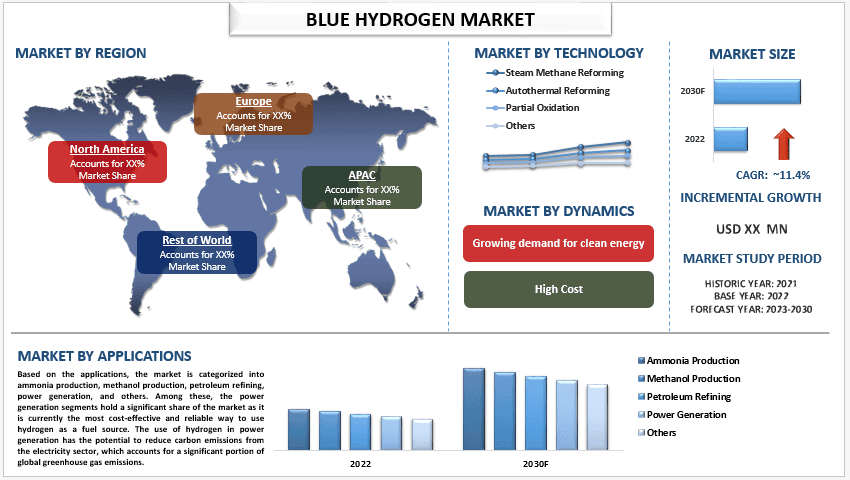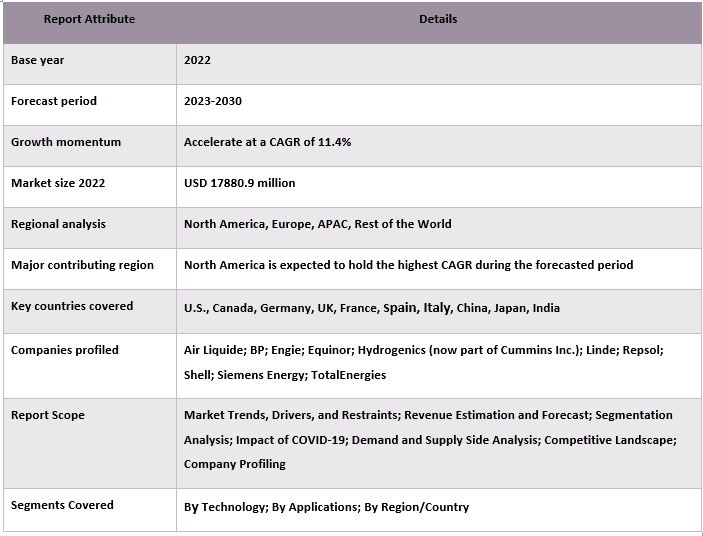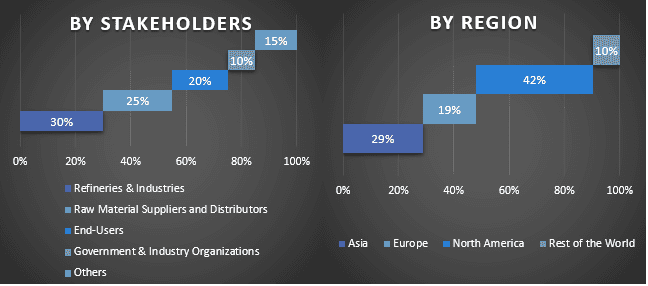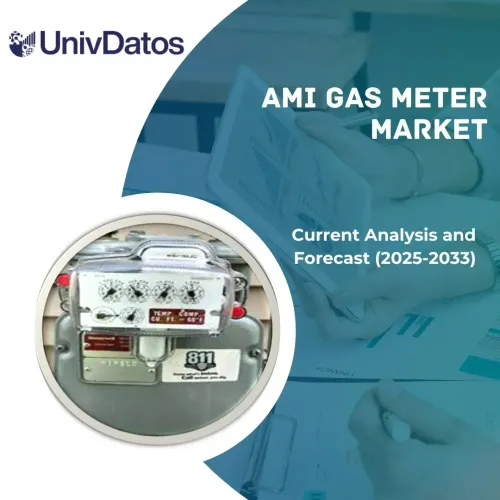- Home
- About Us
- Industry
- Services
- Reading
- Contact Us
Blue Hydrogen Market: Current Analysis and Forecast (2023-2030)
Emphasis on Technology (Steam Methane Reforming, Autothermal Reforming, Partial Oxidation, And Others); Applications (Ammonia Production, Methanol Production, Petroleum Refining, Power Generation, And Others); and Region/Country

The Blue Hydrogen Market was valued at 17880.9 million in 2022 and is expected to grow at a steady rate of around 11.4% during the forecasted period (2023-2030). Blue hydrogen is a type of hydrogen production that involves the use of natural gas, a fossil fuel, to generate hydrogen. The carbon dioxide produced during the hydrogen production process is captured and stored, resulting in a reduction of greenhouse gas emissions compared to traditional fossil fuel-based hydrogen production methods. The blue hydrogen market is expected to grow as countries aim to reduce their greenhouse gas emissions and transition to cleaner energy sources. The development of a hydrogen economy and the increasing demand for hydrogen in industrial processes are driving the growth of the blue hydrogen market. Additionally, the high demand for hydrogen, ammonia, and methanol in the chemical sector is also contributing to the expansion of the blue hydrogen market. For instance, by 2030 in the Announced Pledges Scenario, it is expected that the hydrogen demand for synfuels will reach 1 Mt H2, and by 2050, it will climb to over 15 Mt H2
Some of the major players operating in the market include Air Liquide; BP; Engie; Equinor; Hydrogenics (now part of Cummins Inc.); Linde; Repsol; Shell; Siemens Energy; TotalEnergies.
Insights Presented in the Report
“Amongst technology, steam methane reforming segment is expected to hold a significant share during the forecast period.”
Based on the technology, the market is segmented into steam methane reforming, autothermal reforming, partial oxidation, and others. The steam methane reforming segment is expected to hold a significant share of the blue hydrogen market due to its cost-effective method of producing hydrogen on a large scale. This process involves using natural gas (methane) and steam to extract hydrogen. As natural gas is abundant and relatively inexpensive, it makes blue hydrogen production economically appealing and is driving the market’s growth.
“North America is anticipated to hold a considerable share of the market.”
North America is anticipated to hold a considerable share of the market. North America has a mature renewable energy industry and many hydrogen projects underway, which has created a favorable environment for the development and deployment of blue hydrogen. Among countries, the U.S. is a major player in the blue hydrogen market, with several large-scale projects underway. For example, the Southwest National Renewable Energy Laboratory (SNL) is working on a project to produce blue hydrogen using renewable energy and to store it in underground salt caverns. The project is expected to reduce carbon emissions from the power generation sector in the region by up to 90%. Moreover, Canada is also a significant player in the blue hydrogen market, with several large-scale projects underway. For instance, the Saskatchewan government has announced plans to produce blue hydrogen using renewable energy and to export it to other countries.
Blue Hydrogen Market Report Coverage

Reasons to buy this report:
- The study includes market sizing and forecasting analysis validated by authenticated key industry experts.
- The report presents a quick review of overall industry performance at one glance.
- The report covers an in-depth analysis of prominent industry peers with a primary focus on key business financials, product portfolio, expansion strategies, and recent developments.
- Detailed examination of drivers, restraints, key trends, and opportunities prevailing in the industry.
- The study comprehensively covers the market across different segments.
- Deep dive regional level analysis of the industry.
Customization Options:
The global Blue Hydrogen Market can further be customized as per the requirement or any other market segment. Besides this, UMI understands that you may have your own business needs, hence feel free to connect with us to get a report that completely suits your requirements.
Table of Content
Research Methodology for the Blue Hydrogen Market Analysis (2023-2030)
Analyzing the historical market, estimating the current market, and forecasting the future market of the global blue hydrogen market were the three major steps undertaken to create and analyze the adoption of blue hydrogen in major regions globally. Exhaustive secondary research was conducted to collect the historical market numbers and estimate the current market size. Secondly, to validate these insights, numerous findings and assumptions were taken into consideration. Moreover, exhaustive primary interviews were also conducted, with industry experts across the value chain of the global blue hydrogen market. Post assumption and validation of market numbers through primary interviews, we employed a top-down/bottom-up approach to forecasting the complete market size. Thereafter, market breakdown and data triangulation methods were adopted to estimate and analyze the market size of segments and sub-segments of the industry pertains to. Detailed methodology is explained below:
Analysis of Historical Market Size
Step 1: In-Depth Study of Secondary Sources:
Detail secondary study was conducted to obtain the historical market size of the blue hydrogen market through company internal sources such as annual reports & financial statements, performance presentations, press releases, etc., and external sources including journals, news & articles, government publications, competitor publications, sector reports, third-party database, and other credible publications.
Step 2: Market Segmentation:
After obtaining the historical market size of the blue hydrogen market, we conducted a detailed secondary analysis to gather historical market insights and share for different segments & sub-segments for major regions. Major segments are included in the report like technology and applications. Further country-level analyses were conducted to evaluate the overall adoption of testing models in that region.
Step 3: Factor Analysis:
After acquiring the historical market size of different segments and sub-segments, we conducted a detailed factor analysis to estimate the current market size of the blue hydrogen market. Further, we conducted factor analysis using dependent and independent variables such as various technology and applications of blue hydrogen. A thorough analysis was conducted for demand and supply-side scenarios considering top partnerships, mergers and acquisitions, business expansion, and product launches in the blue hydrogen market sector across the globe.
Current Market Size Estimate & Forecast
Current Market Sizing: Based on actionable insights from the above 3 steps, we arrived at the current market size, key players in the global blue hydrogen market, and market shares of the segments. All the required percentage shares split, and market breakdowns were determined using the above-mentioned secondary approach and were verified through primary interviews.
Estimation & Forecasting: For market estimation and forecast, weights were assigned to different factors including drivers & trends, restraints, and opportunities available for the stakeholders. After analyzing these factors, relevant forecasting techniques i.e., the top-down/bottom-up approach were applied to arrive at the market forecast for 2030 for different segments and sub-segments across the major markets globally. The research methodology adopted to estimate the market size encompasses:
- The industry’s market size, in terms of revenue (USD) and the adoption rate of the blue hydrogen market across the major markets domestically
- All percentage shares, splits, and breakdowns of market segments and sub-segments
- Key players in the global blue hydrogen market in terms of products offered. Also, the growth strategies adopted by these players to compete in the fast-growing market
Market Size and Share Validation
Primary Research: In-depth interviews were conducted with the Key Opinion Leaders (KOLs) including Top Level Executives (CXO/VPs, Sales Head, Marketing Head, Operational Head, Regional Head, Country Head, etc.) across major regions. Primary research findings were then summarized, and statistical analysis was performed to prove the stated hypothesis. Inputs from primary research were consolidated with secondary findings, hence turning information into actionable insights.
Split of Primary Participants in Different Regions

Market Engineering
The data triangulation technique was employed to complete the overall market estimation and to arrive at precise statistical numbers for each segment and sub-segment of the global blue hydrogen market. Data was split into several segments & sub-segments post studying various parameters and trends in the areas of technology and applications in the global blue hydrogen market.
The main objective of the Global Blue Hydrogen Market Study
The current & future market trends of the global blue hydrogen market were pinpointed in the study. Investors can gain strategic insights to base their discretion for investments on the qualitative and quantitative analysis performed in the study. Current and future market trends determined the overall attractiveness of the market at a regional level, providing a platform for the industrial participant to exploit the untapped market to benefit from a first-mover advantage. Other quantitative goals of the studies include:
- Analyze the current and forecast market size of the blue hydrogen market in terms of value (USD). Also, analyze the current and forecast market size of different segments and sub-segments.
- Segments in the study include areas of technology and applications.
- Define and analysis of the regulatory framework for the blue hydrogen industry.
- Analyze the value chain involved with the presence of various intermediaries, along with analyzing customer and competitor behaviors of the industry.
- Analyze the current and forecast market size of the blue hydrogen market for the major region.
- Major countries of regions studied in the report include Asia Pacific, Europe, North America, and the Rest of the World.
- Company profiles of the blue hydrogen market and the growth strategies adopted by the market players to sustain in the fast-growing market.
- Deep dive regional level analysis of the industry
Related Reports
Customers who bought this item also bought










